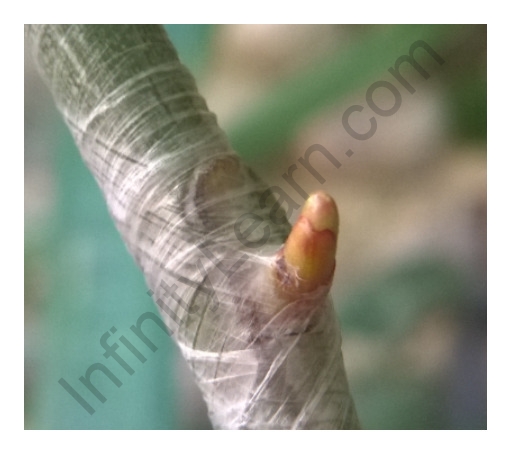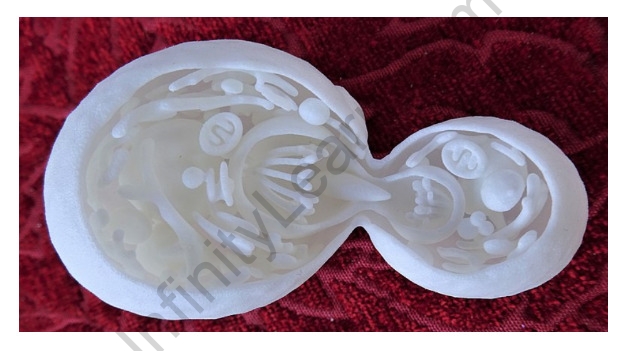Table of Contents
Budding: Budding is a form of asexual reproduction where a new individual develops as an outgrowth or bud from the parent organism. The bud starts as a small projection or swelling on the parent organism and grows over time. Eventually, it detaches from the parent, becoming an independent organism.
During budding, the bud develops its own set of organs and tissues, often resembling the parent organism. The process typically involves the replication of the parent’s genetic material, resulting in genetically identical or very similar offspring.

Types of Budding
There are different types of budding observed in various organisms. Here are some common types of budding:
Exogenous Budding: In exogenous budding, the bud develops on the outer surface of the parent organism. The bud grows in size until it eventually detaches from the parent, forming a new individual. This type of budding is seen in organisms like yeast and certain types of bacteria.
Endogenous Budding: Endogenous budding involves the formation of a bud within the parent organism. The bud grows internally until it reaches a certain size, and then it is released as an independent organism. This type of budding is observed in some protozoa and other single-celled organisms.
Lateral Budding: Lateral budding occurs when the bud forms as a small outgrowth on the side of the parent organism. Over time, the bud grows and develops its own set of organs and tissues. Once fully developed, it separates from the parent organism to become an individual organism. Hydra, a freshwater organism, reproduces through lateral budding.
Basal Budding: Basal budding involves the development of a bud at the base or bottom of the parent organism. The bud grows upward and detaches from the parent, forming a new individual. This type of budding is seen in some plants, such as certain species of ferns.
Apical Budding: In apical budding, the bud forms at the apex or tip of the parent organism. The bud grows in size, eventually separating from the parent and giving rise to a new individual. Some coral species reproduce through apical budding.
Budding in Hydra
Budding in Hydra is a type of asexual reproduction where a new individual, known as a bud, develops as an outgrowth from the body of the parent Hydra organism. Here’s an overview of budding in Hydra
- Process: Budding in Hydra begins with the growth of a small bulge or outgrowth, known as a bud, on the body wall of the parent organism. The bud starts as a tiny bump and gradually develops into a larger structure.
- Bud Development: As the bud grows, it differentiates and forms specialized tissues and organs, including tentacles, a mouth, and a gastrovascular cavity. The bud obtains nourishment from the parent Hydra during its development.
- Tentacle Formation: The bud’s tentacles elongate, resembling those of the parent Hydra. These tentacles help in capturing food and sensing the environment.
- Separation: Once the bud has developed its own set of organs and is capable of independent survival, it detaches from the parent Hydra. This separation occurs at the base of the bud, where it connects to the parent.
- Independent Individual: After separation, the bud becomes an independent Hydra organism. It continues its growth and development, eventually reaching maturity and being capable of budding itself to produce new offspring.
- Repetition: The process of budding can be repeated multiple times in Hydra, allowing for rapid population growth.
Budding in Hydra is a remarkable adaptation that enables them to reproduce and colonize new areas efficiently. It is a form of clonal reproduction, resulting in offspring that are genetically identical or very similar to the parent organism. This method of reproduction allows Hydra to quickly establish new colonies and expand their population in suitable aquatic environments.

It’s important to note that while budding is the primary mode of reproduction in Hydra, they can also reproduce sexually under specific conditions. Sexual reproduction in Hydra involves the formation of gametes (sex cells) and the fusion of genetic material from two individuals to produce genetically diverse offspring.
Budding in yeast is a type of asexual reproduction where a new yeast cell, called a bud, forms as an outgrowth from the parent yeast cell. Here’s an overview of budding in yeast
- Initiation: Budding in yeast begins with the emergence of a small protrusion or bud on the surface of the parent yeast cell. The bud initially appears as a small bump or swelling.
- Bud Growth: The bud grows in size as it receives nutrients and cellular components from the parent cell. It gradually enlarges, becoming more distinct and visible.
- DNA Replication and Nucleus Division: Before the bud fully separates from the parent cell, the genetic material (DNA) in the parent cell is replicated, and the nucleus divides. This ensures that the bud receives a complete set of genetic information.
- Organelle Distribution: As the bud grows, various organelles, such as mitochondria and vacuoles, are distributed between the parent cell and the developing bud. This ensures that both the parent and the bud have the necessary cellular components.
- Bud Maturation: The bud continues to grow and matures, forming its own cell wall and plasma membrane. It develops into a fully functional yeast cell with its own organelles and cellular machinery.
- Separation: Eventually, the bud reaches a sufficient size and separates from the parent yeast cell. This separation occurs at a specific location on the parent cell’s surface, leaving behind a small scar or remnant.
- Independent Cell: Once separated, the bud becomes an independent yeast cell capable of carrying out all necessary cellular functions, including growth, metabolism, and reproduction.
- Repetition: Budding in yeast can occur repeatedly, with each bud having the potential to develop into a new yeast cell and initiate its own budding process.

Budding is a highly efficient method of reproduction in yeast, allowing for rapid population growth and colonization of new environments. It enables yeast to multiply quickly under favorable conditions and adapt to various ecological niches.
It’s worth noting that budding in yeast is also used in various biotechnological applications, such as the production of fermented foods and beverages, as well as the manufacturing of certain pharmaceuticals and industrial chemicals.
Conclusion
Budding is commonly observed in organisms such as yeast, hydra, and some types of coral. Each organism has its own unique mechanism of budding. For instance, in yeast, a small bud forms on the parent cell, grows in size, and eventually separates to become a new individual. In hydra, a bud develops as a small outgrowth on the side of the parent organism and eventually detaches, giving rise to a new individual.
Budding is advantageous in environments where resources are abundant and conditions are favorable. It allows for rapid reproduction, enabling the parent organism to produce multiple offspring without the need for a mate or the production of specialized reproductive cells. The offspring produced through budding are genetically identical or closely resemble the parent, ensuring the preservation of successful traits.
Overall, budding is an important mode of reproduction in various organisms and contributes to their ability to colonize new habitats and increase their population size.
Frequently Asked Questions on Budding
What is budding in biology?
Budding in biology refers to a form of asexual reproduction where a new organism, called a bud, grows and develops as an outgrowth from the body of the parent organism.
How does budding occur?
Budding occurs when a small projection or bud forms on the parent organism. The bud grows in size, develops its own set of organs and tissues, and eventually separates from the parent to become an independent organism.
What organisms reproduce through budding?
Budding is observed in various organisms, including yeast, hydra, some types of coral, certain plants, and even some bacteria.
How is budding different from other forms of reproduction?
Budding differs from other forms of reproduction, such as sexual reproduction, as it involves the development of a new individual from an outgrowth of the parent organism, rather than the fusion of gametes (sex cells) from two parents.
What is the purpose of budding?
The purpose of budding is to enable rapid reproduction and population growth. It allows organisms to produce genetically identical or closely resembling offspring without the need for a mate or the production of specialized reproductive cells.
What are the advantages of budding?
The advantages of budding include rapid reproduction, efficient population growth, and preservation of desirable traits since offspring are genetically identical or similar to the parent organism.
Are there any disadvantages to budding?
One disadvantage of budding is the lack of genetic diversity, which can limit the ability of the population to adapt to changing environments. Additionally, the accumulation of detrimental mutations in the genetic material is not eliminated through recombination, potentially reducing overall fitness.
Can organisms that reproduce through budding also reproduce sexually?
Yes, some organisms that primarily reproduce through budding, such as hydra and yeast, can also reproduce sexually under specific conditions. Sexual reproduction allows for genetic recombination and increased genetic diversity.
Are there variations in budding among different organisms?
Yes, budding can vary among organisms. For example, in yeast, budding involves the formation of a bud on the surface of the parent cell, while in hydra, budding occurs as an outgrowth from the body of the parent organism. Each organism has its own unique mechanisms and variations of budding.






